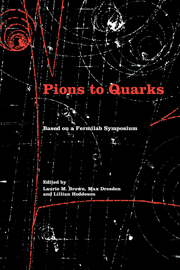Book contents
- Frontmatter
- Contents
- List of contributors
- Foreword by Leon M. Lederman
- Editors' acknowledgments
- Photographs of the symposium
- List of abbreviations
- List of notation
- I Introduction
- II Particle discoveries in cosmic rays
- III High-energy nuclear physics
- IV The new laboratory
- 9 The making of an accelerator physicist
- 10 Accelerator design and construction in the 1950s
- 11 Early history of the Cosmotron and AGS at Brookhaven
- 12 Panel on accelerators and detectors in the 1950s
- 13 Accelerators and the Midwestern Universities Research Association in the 1950s
- 14 Bubbles, sparks, and the postwar laboratory
- 15 Development of the discharge (spark) chamber in Japan in the 1950s
- 16 Early work at the Bevatron: a personal account
- 17 The discovery of the antiproton
- 18 On the antiproton discovery
- V The strange particles
- VI Weak interactions
- VII Weak interactions and parity nonconservation
- VIII The particle physics community
- IX Theories of hadrons
- X Personal overviews
- Name index
- Subject index
13 - Accelerators and the Midwestern Universities Research Association in the 1950s
Published online by Cambridge University Press: 07 May 2010
- Frontmatter
- Contents
- List of contributors
- Foreword by Leon M. Lederman
- Editors' acknowledgments
- Photographs of the symposium
- List of abbreviations
- List of notation
- I Introduction
- II Particle discoveries in cosmic rays
- III High-energy nuclear physics
- IV The new laboratory
- 9 The making of an accelerator physicist
- 10 Accelerator design and construction in the 1950s
- 11 Early history of the Cosmotron and AGS at Brookhaven
- 12 Panel on accelerators and detectors in the 1950s
- 13 Accelerators and the Midwestern Universities Research Association in the 1950s
- 14 Bubbles, sparks, and the postwar laboratory
- 15 Development of the discharge (spark) chamber in Japan in the 1950s
- 16 Early work at the Bevatron: a personal account
- 17 The discovery of the antiproton
- 18 On the antiproton discovery
- V The strange particles
- VI Weak interactions
- VII Weak interactions and parity nonconservation
- VIII The particle physics community
- IX Theories of hadrons
- X Personal overviews
- Name index
- Subject index
Summary
The possibilities of a great increase in the energy of particles opened up by the invention of alternating-gradient focusing aroused great interest in the Midwest. One result was the establishment of the Midwestern Universities Research Association (MURA) to build a large accelerator for the midwestern region. It was a time when there was much to be learned about accelerator design. To achieve the best results from machines, which were becoming conspicuously expensive, it was important to understand orbit behavior fully. The application of the digital computer after 1952, particularly at Brookhaven and at the University of Illinois, revealed the necessary details of manipulations of synchrotron and betatron phase space in the presence of realistic nonlinearities and perturbations.
At the dedication of the Brookhaven Cosmotron (on 15 December 1952), Samuel K. Allison of the University of Chicago and P. Gerald Kruger of the University of Illinois suggested that a meeting of the scientists in the midwestern region of the United States should be called to consider ways of providing a high-energy facility for that part of the country. The meeting, held on 17 and 18 April 1953, at the University of Chicago, was attended by a large number of midwestern scientists interested in high-energy research. The group invited Ernest Courant, John Blewett, and Robert R. Wilson, who were already working with the design problems of alternating-gradient accelerators, to give talks. Courant explained the problems of misalignment and the choice of optimum parameters for an alternating-gradient synchrotron.
- Type
- Chapter
- Information
- Pions to QuarksParticle Physics in the 1950s, pp. 202 - 212Publisher: Cambridge University PressPrint publication year: 1989

